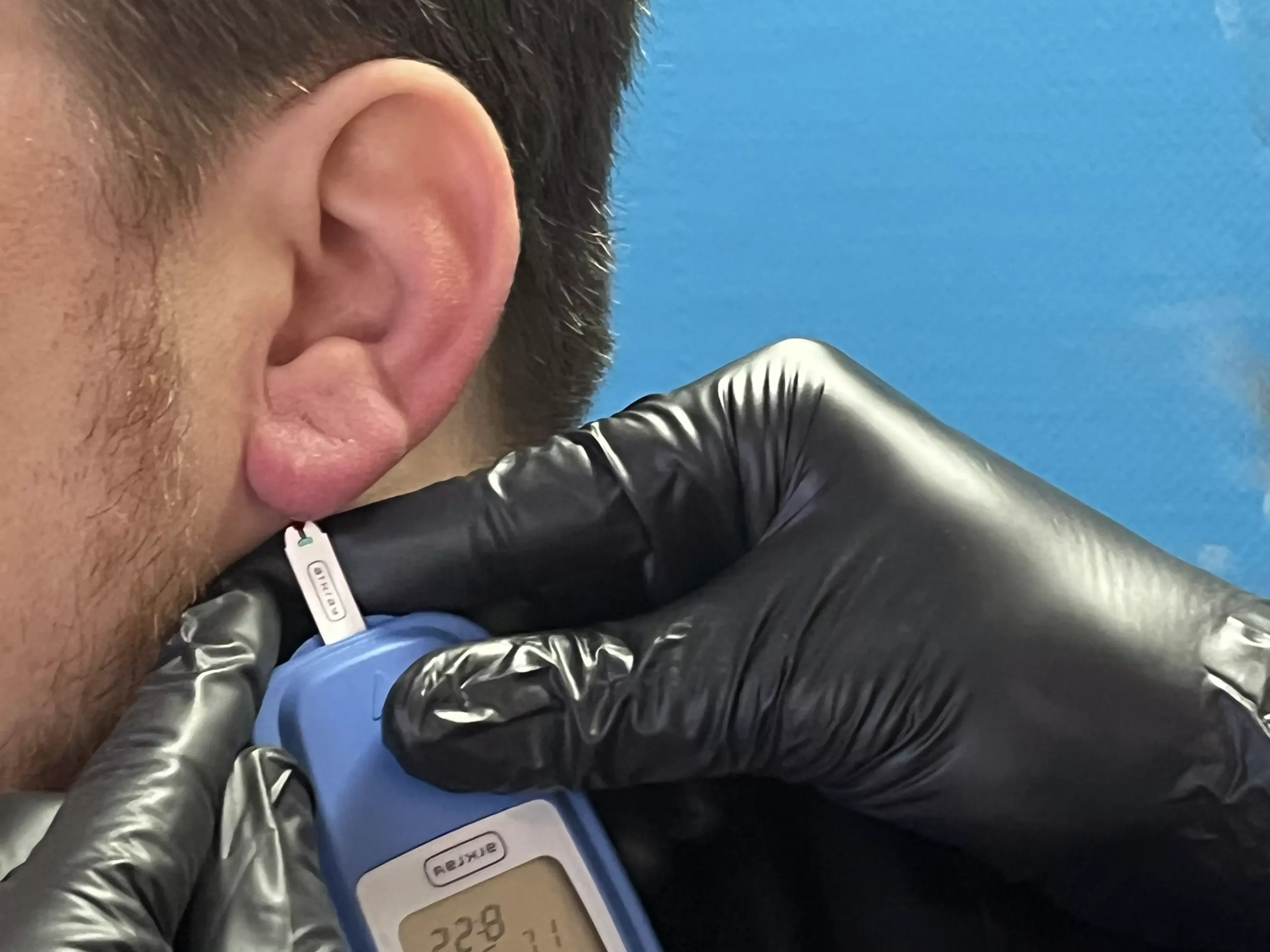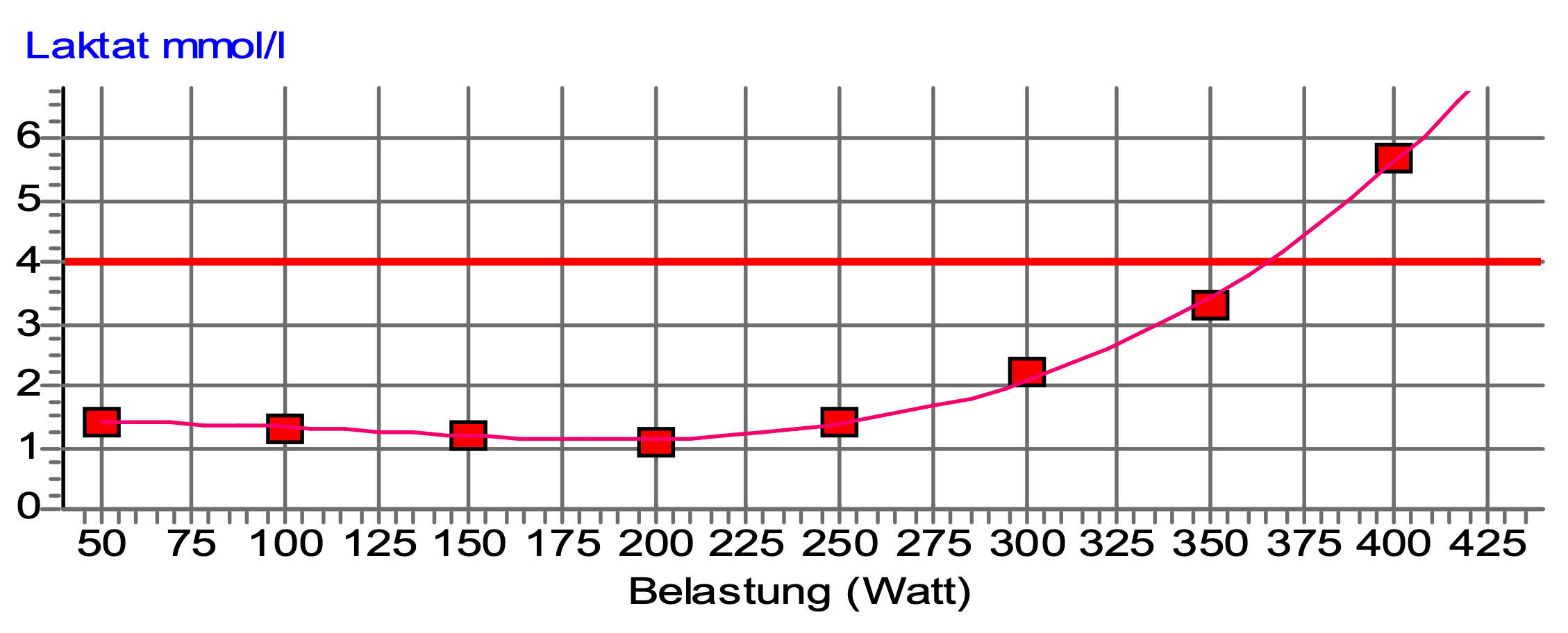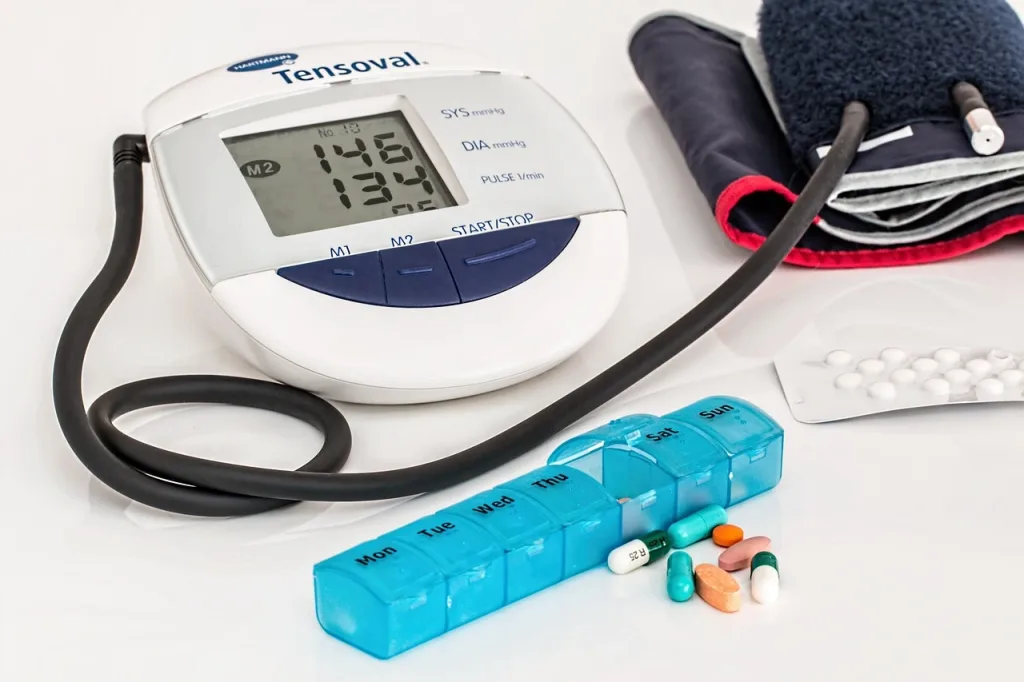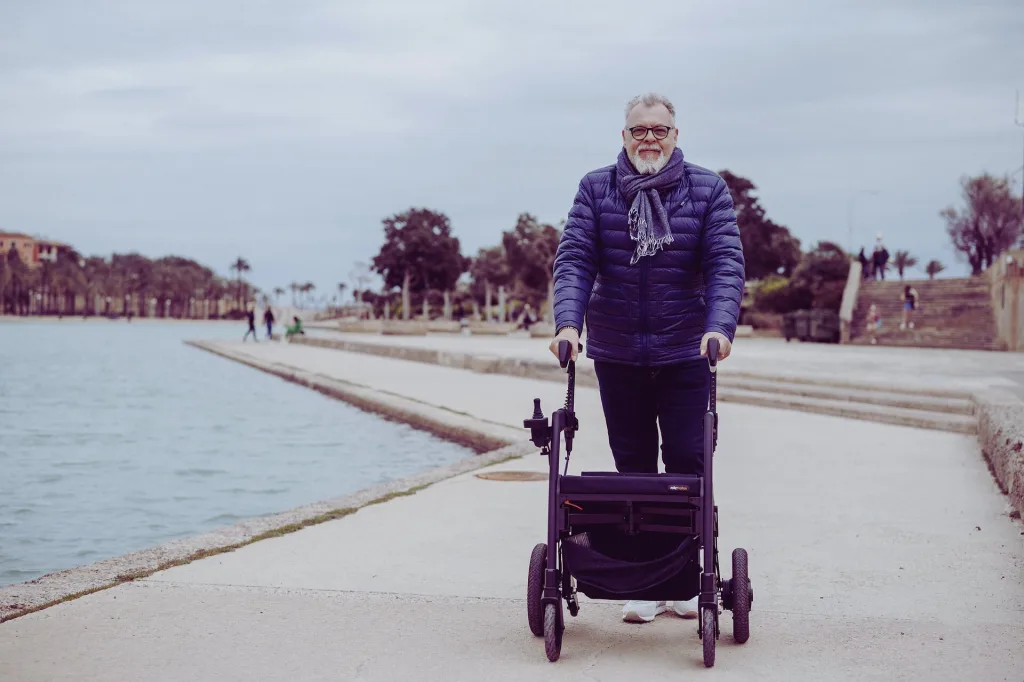Performancediagnostik & Trainingscontrol
Lactate Performance Test
WHY IS A SPORTS MEDICAL PERFORMANCE TEST IMPORTANT?
In order to be able to give a serious recommendation for training (type, scope, intensity), the individual physical performance is determined in advance. We usually get the information for this from a performance test on the ergometer.
Lactate conduction diagnostics or the lactate step test is one of the most valuable measurement methods for determining general fitness and optimal training planning. It is a quick and cost-effective way to specifically boost fat metabolism.
It is also possible to carry out the diagnostics on our treadmill.

- Am I fit for sports and healthy?
- How is my fitness and performance?
- What could be training goals?
- Specific
- Measurable
- Achievable
- Realistic
- Timely defined
- How is the previous training to be classified in terms of scope and intensity
- How can I improve my health and performance through physical training?
- What kind of exercise should I choose to lower my blood pressure.
- Are there any health risks if I do sports?
- What should be considered if weight reduction should be the goal.
- What role does nutrition play if I want to improve my performance? (The internet is full of conflicting information.)
- My goal is to take part in a (half)marathon or triathlon. Do I have the physical requirements for this? How should I prepare for this and approach the training correctly?
Performance
diagnostics
&
Training
control
lactate
performance
diagnostics
WHY IS A SPORTS MEDICAL PERFORMANCE TEST IMPORTANT?
In order to be able to give a serious recommendation for training (type, scope, intensity), the individual physical performance is determined in advance. We usually get the information for this from a performance test on the ergometer.
Lactate conduction diagnostics or the lactate step test is one of the most valuable measurement methods for determining general fitness and optimal training planning. It is a quick and cost-effective way to specifically boost fat metabolism.
It is also possible to carry out the diagnostics on our treadmill.
- Am I fit for sports and healthy?
- How is my fitness and performance?
- What could be training goals?
- Specific
- Measurable
- Achievable
- Realistic
- Timely defined
- How is the previous training to be classified in terms of scope and intensity
- How can I improve my health and performance through physical training?
- What kind of exercise should I choose to lower my blood pressure.
- Are there any health risks if I do sports?
- What should be considered if weight reduction should be the goal.
- What role does nutrition play if I want to improve my performance? (The internet is full of conflicting information.)
- My goal is to take part in a (half)marathon or triathlon. Do I have the physical requirements for this? How should I prepare for this and approach the training correctly?

How it's done
In lactate performance diagnostics, the organism is subjected to increasing strain at certain levels. For example, on a bicycle ergometer. After each level of strain (6 minutes), a tiny drop of blood is taken from the earlobe. The lactate concentration is determined using a special device. At the same time, the heart rate is documented.
Initial Diagnosis
The first diagnostics are carried out to the point of exhaustion. Valuable insights into the absolute resilience of the body are gained here.
Follow-Up Diagnostics
With known performance, follow-up diagnostics focus on the area to be developed. Fewer, but longer, load levels are used.
Identify
Training
Cues
With lactate performance diagnostics, it is possible to find out which energy sources are tapped into during certain physical stresses on the body. This enables a clear training recommendation to expand the capacities in fat metabolism.
Fast and Accurate
The measurement of lactate is a relatively inexpensive method that can be carried out quickly and easily and achieves very reliable results.
Spiroergometry also produces good results, but the technical effort is significantly greater.
The methods commonly used to determine fitness levels and to control training are based on determining heart rate under different levels of exertion. However, due to the high fluctuation in heart rate, this parameter alone is not sufficient and is very inaccurate. This is where commercially available technical aids such as heart rate monitors, fitness bands, etc. come into play. However, they do not produce reliable results that enable a solid training plan.
Also by means of a rule of thumb (200 – age, etc.) advice is given, which unfortunately all have to be sorted into the drawer "dubious".

BENEFIT
With lactate performance diagnostics, it is possible to find out which energy sources are tapped into during certain physical stresses on the body. This enables a clear training recommendation to expand the capacities in fat metabolism.
Prevention
(health care)
The principles of training apply not only for improvement of performance in sports, but also the can be also applied with great succes in prevention settings. Prevention übertragen.
If you want to integrate exercise and sport into your life in such a way that you also reap long-term health benefits, you should invest in your most important training equipment: Your Body
Prevention is responsibility and precaution for one's own health, one's own body and psyche.
"Move more, do sports" or something similar is often the general advice when it comes to establishing a healthy lifestyle.
Bewegung allein reicht nicht. If you just start moving, you can make a lot of mistakesMovement alone is not enough. If you just start moving like that, you can also do a lot wrong. As the saying goes: "The dose makes the poison!" And if movement is the medicine, the dose should be well balanced.
healthy food
In order to achieve the desired effects, you need the right fuel. Nutrition, i.e. the supply of the required nutrients, plays an important role!
... or have you ever seen a racing driver pour heavy fuel oil into his tank?
Dealing with thoughts and feelings correctly also helps you stay mentally healthy.
Stress vs. Overload
Plato already knew: "The surest way to health is to prescribe to each person the exact necessary dose of food and exercise: not too much and not too little."
But the "medication movement" must be dosed precisely. Simply training in the dark, or carrying out training according to any mathematical formulas that are not tailored to your own body, can very quickly overload and cause damage.
Never train on dysfunktion
If you are planning to start exercising for the first time after a long break, for example after an injury or illness, it is advisable to have the functions of your musculoskeletal system checked. Restrictions on movement in certain parts of the body can quickly lead to overload and pain in the compensation area.
the right start
The most important and first step is always the analysis. Using lactate performance diagnostics, we determine your individual training intensities.
At regular intervals, depending on the goal, it is useful to repeat the test in order to further adapt the training.
This is healthy exercise that works, guarantees you success and does not harm!
Benefit of intelligent training
- improved physical performance
- improved ability to concentrate
- lower risk of heart attack
- lower blood pressure
- improved blood lipid levels
- permanent weight management
- reduces body fat percentage
- stronger immune system
- better stress tolerance
- strengthened bone structure
- better quality of cartilage, tendons, ligaments
- better attitude towards life
Prevention
(health care)
The principles of training apply not only for improvement of performance in sports, but also the can be also applied with great succes in prevention settings. Prevention übertragen.
If you want to integrate exercise and sport into your life in such a way that you also reap long-term health benefits, you should invest in your most important training equipment: Your Body
Prevention is responsibility and precaution for one's own health, one's own body and psyche.
"Move more, do sports" or something similar is often the general advice when it comes to establishing a healthy lifestyle.
Bewegung allein reicht nicht. If you just start moving, you can make a lot of mistakesMovement alone is not enough. If you just start moving like that, you can also do a lot wrong. As the saying goes: "The dose makes the poison!" And if movement is the medicine, the dose should be well balanced.
Optimize
&
Nutritiuon
In order to achieve the desired effects, you need the right fuel. Nutrition, i.e. the supply of the required nutrients, plays an important role!
... or have you ever seen a racing driver pour heavy fuel oil into his tank?
Dealing with thoughts and feelings correctly also helps you stay mentally healthy.
Load
vs.
Resilience
Plato already knew: "The surest way to health is to prescribe to each person the exact necessary dose of food and exercise: not too much and not too little."
Platon
The medication "movement" must be dosed precisely. Simply training in the dark, or carrying out training according to any mathematical formulas that are not tailored to your own body, can very quickly overload and cause damage.
Never
train
on
dysfunktion
If you are planning to start exercising for the first time after a long break, for example after an injury or illness, it is advisable to have the functions of your musculoskeletal system checked. Restrictions on movement in certain parts of the body can quickly lead to overload and pain in the compensation area.
The
ideal
start
The most important and first step is always the analysis. Using lactate performance diagnostics, we determine your individual training intensities.
At regular intervals, depending on the goal, it is useful to repeat the test in order to further adapt the training.
This is healthy exercise that works, guarantees you success and does not harm!
personal
training
Do you have sporting goals and problems implementing them? Again and again you are thrown back in your training because complaints thwart your training plan. Then it's time for an error analysis. The problems often lie in the running technique, a lack of flexibility or an unfavorable training plan. Put yourself to the test and we will find a solution.
RUNNING TECHNIQUE MOBILITY | TRAINING CONSULTING
for (half)marathon / triathlon by top athlete (Ironman winner) Michael Wegricht Michael Wegricht

training
with
medical
conditions
Acute pain has a warning function, chronic pain usually not. Pain then becomes the disease itself, it is a disease on it's own.
Anyone who suffers from chronic pain is also mentally stressed. Stress, tension and anxiety - feelings that chronic pain patients know all too well. These lead to those affected taking it easy, limiting leisure activities and social contacts, and perhaps even giving up entirely. This can promote the development of depression. Sleep disorders, anxiety disorders, psychoses and stress disorders can also occur.
Find out what solutions can look like so that pain is finally a thing of the past!
Long COVID is the general term for the health problems and long-term consequences that can occur after infection with the SARS-CoV-2 coronavirus. The currently scientifically ambiguous term "Long COVID" includes symptoms that persist, worsen or reappear more than four weeks after infection with the coronavirus. If symptoms persist after three months and persist or recur for at least two months, they are referred to as post-COVID syndrome.
About 30 percent of all German citizens suffer from this vascular disease. If left undetected and untreated, it can have serious consequences. About 50 percent of all strokes, Heart attacks and peripheral arterial occlusive diseases could be avoided if those affected recognized their high blood pressure in good time and had it treated.
WHEN DO YOU TALK ABOUT HIGH BLOOD PRESSURE?
normal blood pressure
In healthy people, the optimal blood pressure value of the systolic pressure is 120-129 mmHg, that of the diastolic pressure is 80-84 mmHg.
High blood pressure
High blood pressure, which is still considered normal, is when the systolic pressure is 130 to 139 mmHg and the diastolic pressure is 85 to 89 mmHg.
Arterial hypertension grade I
Mild high blood pressure is when the systolic pressure is between 140 and 159 and the diastolic pressure is between 90 and 99 mmHg.
Arterial hypertension grade II
A value of 160 to 179 mmHg or 100 to 109 mmHg is considered moderate high blood pressure.
Arterial hypertension grade III
Severe blood pressure is when the systolic pressure is over 180 mmHg and the diastolic pressure is over 110 mmHg. Patients whose systolic pressure is greater than 140 mmHg while diastolic pressure is less than 90 mmHg suffer from isolated systolic hypertension.
THE MAIN RISK FACTORS
- Stress
- lack of exercise
- smoking
- alkohol
- unhealthy food
- too much (fattened) meat
- too much unhealthy fats
- too much salt
THERAPY
Most important:
- regular physical training
- Stressmanagement
- weight reduction
- diet change
- minimizing risk factors
- nicotine
- alkohol
These measures are accompanied by many other positive health effects. Examples would be:
- higher stress tolerance
- improved physical performance
- improved blood lipid levels
- Reduced body fat (particularly belly fat)
- stronger immune system
- better quality of connective tissue (Fascia)
- better attitude towards life
Hypertension should be controlled with medication. With intelligent training and medical supervision, these medications can be reduced over time or stopped altogether.
Burnout is a state of being physically, mentally and spiritually "burned out", a disease that affects more and more people today and that can affect anyone.
Those affected often do not know how to deal with this feeling of being overwhelmed, where the causes lie and how they can find their way back to their full potential, mental strength and physical and psychological health.
The path to burnout hits people who are characterized by above-average commitment in their job and life and has nothing to do with personal failure. Burnout sufferers often shy away from common drug and psychiatric treatment methods.
A Depression is a serious mental illness that can occur at any age. Those affected feel very depressed, lose their interests and are exhausted and listless. The disease is long-standing and rarely gets better on its own without treatment.
Symptoms
- Main Symptoms
- deep dejection
- loss of interest
- listlessness
- Side Symptoms
- insomnia
- self-doubt
- guilt
- difficulty concentrating
Treatment
- Psychotherapy
- Medication
- controlled aerobic endurance program
The Metabolic Syndrom is occasionally also called deadly quartet, Reaven-Syndrom or Syndrom X designated. It is considered (along with smoking) to be the key risk factor for arterial disease, especially coronary artery disease, and is characterized by the following four factors:
- Abdominal obesity
- High blood pressure (also highly normal values from 130 mmHg systolic)
- Lipid metabolism disorder with hypertriglyceridemia and low HDL cholesterol
- Insulin resistance or impaired glucose tolerance
read the whole article here on Wikipedia
THERAPY
The focus is on reducing hyperinsulinemia and dyslipidemia. A significant improvement is often already achieved through lifestyle changes .
Most Important:
- regular physical training
- weight reduction
- diet change
- minimizing risk factors
- nicotine
- alkohol
These measures will most likely affect both insulin balance and cholesterol levels.
Hypertension should be controlled with medication. Drug therapy is also indicated for persistent dyslipidemia and/or hyperglycemia.
Almost all oncological diagnoses can be positively influenced by individually adapted training!
Structured physical training for cancer patients can help reduce or avoid complications and side effects during and after oncological therapy. It also allows patients to improve their own subjective well-being. Studies show that side effects such as fatigue syndrome can be successfully treated.
The Cancer Society writes:
The effects of exercise on cancer patients have recently been increasingly investigated in clinical studies. It has been shown that physical activity can measurably reduce the side effects of chemotherapy or anti-hormonal therapy. It also increases performance and strengthens self-confidence - which can greatly improve the quality of life. But that's not all: physical activity also has a direct influence on the development of cancer, the course of cancer and the risk of relapse. It therefore makes a contribution to the prevention of cancer in primary, secondary and tertiary prevention. Sport can also improve the quality of life during the illness.
Make an appointment and find out what your individual exercise plan could look like.
Prehabilitation
Preparing for an operation
For example, if a hip operation is pending, it is advisable to pull out all the stops in order to achieve the most perfect healing possible.
It is also helpful to familiarize yourself in advance with the exercises that are to be carried out after an operation. Motion sequences that the brain has already become acquainted with can be implemented better after the operation.








